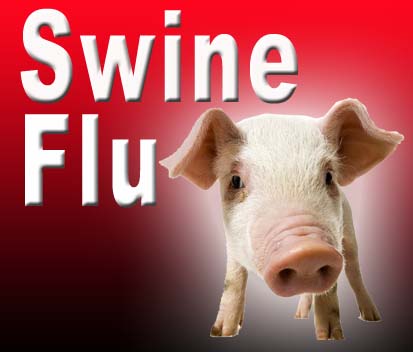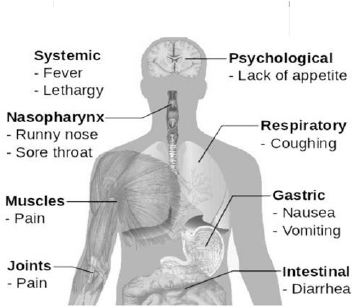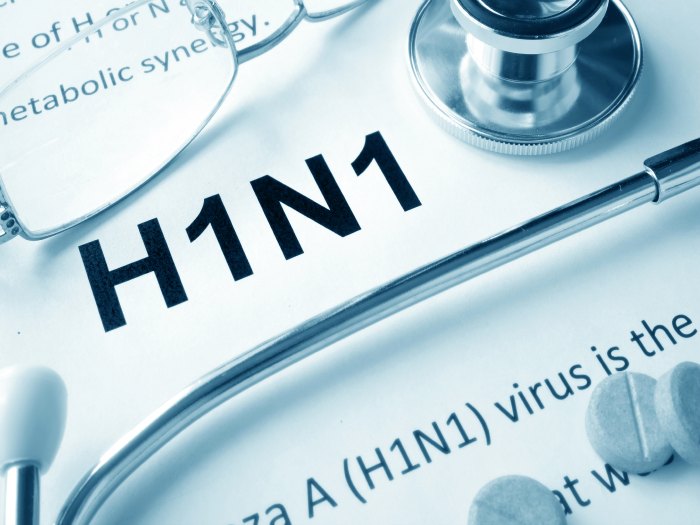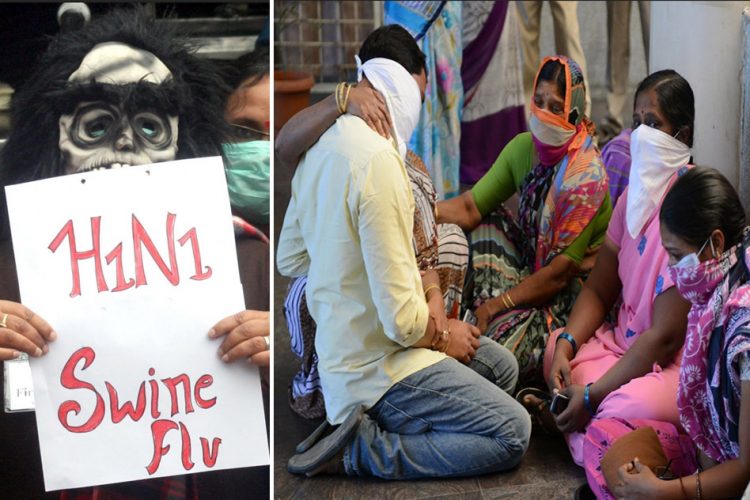
H1N1 (Swine Flu) பன்றி காய்ச்சல் Symptoms of H1N1 swine flu Diagnosis and Treatment
Symptoms of Swine Flu
Frequent Symptoms
Like different seasonal influenza viruses, common symptoms of swine flu (H1N1) develop between one and 3 days once you have been infected
1) Fever, that is typically high, however, is usually absent
2) A cough
3) Runny or stuffy nose
4) A sore throat
5) Body aches
6) A headache
7) Chills
8) Fatigue or weariness, which may be extreme
9) Diarrhea and vomit sometimes, but a lot of normally seen than with different strains of flu

Serious Symptoms in Kids
1) Fast breathing or problem respiratory
2) Bluish or grey skin color
3) Not drinking enough fluids
4) Severe or persistent vomiting
5) Not wakening or not interacting
6) Irritability therefore nice that your kid doesn’t want to be held
7) Flu-like symptoms get better|bounce back|retrieve|restore|reclaim|regain} then again come back with fever and worse cough
8) Rash with a fever
Serious Symptoms in Adults
1) Difficulty respiratory
2) Chest pain or pressure
3) Abdominal pain or pressure
4) Dizziness
5) Confusion
6) Vomiting that is severe or won’t stop
7) Flu-like symptoms recover|bounce back|retrieve|restore|reclaim|regain} then again come back with fever and worse cough
8) If you notice these, do not panic quickly. it is important to coordinate with a doctor or your medical team for prompt attention, and they can assist you to resolve the issue and its underlying cause.
Causes
H1N1 influenza is caused by influenza a virus. The letters H and N within the subtype name symbolize proteins found on the surface of the virus, that are used to distinguish between completely different influenza A subtypes.
Influenza viruses are perpetually ever-changing their genes, a method called mutation. Once a swine influenza virus is found in humans, it’s same to possess “jumped the species barrier.” this means that the virus has mutated in a very approach that enables it to cause the condition in humans. as a result of humans have no natural protection or immunity to the virus, they’re likely to become ill. The H1N1 influenza virus is formed of genes from influenza viruses that ordinarily cause influenza in pigs, birds, and humans.
H1N1 influenza virus is contagious. Person-to-person transmission of H1N1 influenza virus happens, and the virus is well spread among people. It’s believed that it’s spread the same approach as regular seasonal influenza. an individual infected with H1N1 {flu|influenza|grippe|contagious disease|contagion|respiratory disease|respiratory unwellness|respiratory disorder} virus will infect others beginning one day before symptoms develop and up to seven or a lot of days when becoming ill. Influenza is spread from person to person once the virus enters the body through the eyes, nose, and/or mouth.
Coughing and symptom release the germs into the air, wherever they can be breathed in by others. The virus may also rest on hard surfaces like doorknobs, ATM buttons, and counters. a person WHO touches these surfaces with their hands and so touches their eyes, mouth, or nose will become infected with the virus. Influenza is mostly not spread by feeding food or drinking water.
Diagnosis
Self-Checks/At-Home Testing
There are not any home testing kits that are correct or approved for any type of influenza, including H1N1 influenza.
It is vital to apprehending |to understand|to grasp} the symptoms of H1N1 influenza so that you may know if you need to visualize your health care supplier to be tested. Though the symptoms are almost like those of the many other higher metabolic process viruses, the influenza is usually a lot of severe and its onset is explosive. not like a cold, that comes on gradually over many days, influenza hits you all at once with severe symptoms like fatigue, fever, and muscle aches.
Labs and Tests

If you think you might have influenza, see your health care supplier within the primary forty-eight hours of the beginning of your symptoms. If you need treatment with antiviral medicine, it’ll be the foremost effective if it started early in the health problem.
If your health care supplier examines you and thinks you might have H1N1 influenza, there are many tests he would possibly use to diagnose you. the foremost common is a fast influenza test. This consists of a nasal or throat swab that gives fast leads to the office in under twenty minutes. looking on the test, you’ll either be told that you {simply|that you just} simply do or don’t have influenza (influenza), or you do or don’t have influenza A or B.
Treatment and prevention
The H1N1 strain is included in the seasonal influenza vaccinum. There are medications available to help in the barn treatment of H1N1 influenza. These are called antiviral medications. There are two categories available: M2 inhibitors (e.g., amantadine*) and neuraminidase inhibitors(e.g., oseltamivir, zanamivir).
Most people with previously according to H1N1 influenza are able to recover absolutely without medical attention and while not antiviral medications.
However, the prevalence of outbreaks indicates that treatment with antivirals could also be required, particularly for folks that have moderate-to-severe symptoms and for folks that square measure in danger for complications of contagion (e.g., folks with underlying medical conditions).
There are ways to protect yourself from catching the H1N1 influenza virus.

Experts say that the steps you should want to protect yourself from swine {flu|swine influenza|influenza|flu|grippe} aren’t abundant totally different than those you may want to obstruct seasonal flu.
1. Do not bit your face
Above all, keep your hands aloof from your eyes, mouth, and nose, all of that function pathways for the virus to enter your track, says Allison Aiello, AN medical scientist at the University of Michigan faculty of Public Health in Ann Arbor.
2. Wash your hands
If you need to bit your face, scrub your hands, obtaining underneath the fingernails and within all crevices, for twenty to thirty seconds with hot soap and water beforehand, Aiello says. “In addition to dislodging dirt which will contain virus particles, soaps contain surfactants [the primary elements of detergents] which may harm the macromolecule [fat] protective virus particles,” she explains. Soap ought to so be effective against all contagion viruses.
3. Use a hand sanitizer
No sink nearby? Then use AN alcohol-based hand sanitizer, Aiello advises. a few quarter-size spots, rubbed everywhere the hands till the sanitizer evaporates (usually ten to fifteen seconds), ought to have it away. Alcohol will inactivate viruses by destroying the structure of their proteins, she notes.
4. Cowl your nose and mouth
When somebody sneezes or coughs, liquid droplets packing contagion viruses will travel as way as 3 feet (one meter) through the air and descend on your nose or mouth, thus it is best to keep up a minimum of AN arms-length distance once reproof somebody UN agency shows signs of infection, says Louise Dembry, director of medicine at Yale-New Haven Hospital in Connecticut. And to guard others, cowl your mouth and nose with a tissue once you a cough or sneeze, and clean your hands subsequently, she says, noting that viruses will stay infectious for hours, if not longer after they linger on the skin or different surfaces like keyboards and subway poles.
5. Contemplate shopping for a mask just in case you would like it within the future
From press photos, it looks that Mexico’s entire population has donned surgical masks, however, the decision remains out on however effective they’re in stemming the unfold of contagion, in keeping with Aiello. Some analysis suggests that masks—either the surgical selection or respirators known as N95’s specially designed to filter water droplets containing viruses—reduce the chance of acquiring the contagion or different metabolism pathogens by the maximum amount as eighty %, however analysis by Aiello’s team suggests that masks do very little unless employed in conjunction with diligent hand laundry.
What am I able to do to guard myself against obtaining sick?

Currently offered seasonal grippe immunogen doesn’t shield against H1N1 contagion. There are everyday actions which will facilitate stop the unfold of germs that cause metabolism sicknesses like grippe. Take these everyday steps to guard your health:
1) Cowl your nose and mouth with a tissue once you a cough or sneeze. Throw the tissue within the trash once you employ it.
2) Wash your hands usually with soap and water, particularly once you a cough or sneeze. Alcohol primarily based hand cleaners also are effective.
3) Avoid touching your eyes, nose or mouth. Germs unfold this fashion.
4) Attempt to avoid shut contact with folks having respiratory disease.
5) If one gets sick with grippe, one should lodge in the home, aloof from work or faculty and limit contact with others to stay from infecting them. However, if one has any metabolism distress, one ought to report back to a close-by hospital.
